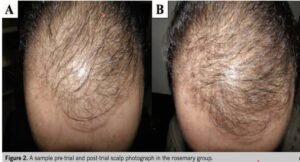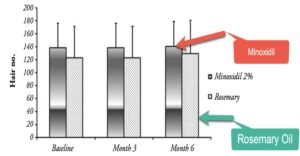One of the many natural cures for hair loss is rosemary oil. However, one difference between this essential oil and other DIY remedies is that some research suggests it may help men and women who deal with baldness caused by androgenic alopecia. Let's look at the proof of rosemary oil for hair regrowth and what you need to know if you try this for yourself.
Rosemary Oil Hair Regrowth Research
In one investigation, in a randomized comparative trial, rosemary oil was compared to 2% minoxidil for the treatment of androgenic alopecia. This clinical trial is pretty straightforward: it's a six-month-long investigation where 100 young men with stage II and stage III androgenic alopecia hair loss are split into two equal groups:
- 50 men use a 2% solution of minoxidil (Rogaine).
- 50 men use topical rosemary oil on their heads.
The aromatic rosemary extract was standardized to contain at least 3.7 mg of eucalyptol (1,8-cineole) per ml of the product. Eucalyptol is known to have both anti-inflammatory and antioxidant effects via its regulation of Nrf2 and KF-kB.
Their average age was 24 years. Each group used just over 1/2 teaspoon (2 ml) of either rosemary essential oil or minoxidil daily. Specifically, they used one milliliter in the morning and another one-milliliter dose 12 hours later. Each solution was massaged into the scalp and left in place to improve penetration. In other words, they did not wash either solution out of their hair.
Results
The researchers reported that after three months of treatment, the average number of hairs counted on the heads of these individuals did not differ between each group. In other words, rosemary oil and minoxidil appeared to improve hair loss the same. After three months, 123 hairs were counted in the rosemary oil group, and 138 hairs were counted on the heads of those using minoxidil. These numbers were not significantly different from each other.
Rosemary Oil vs. Minoxidil Before & After Pictures
Here is a before and after picture of one man who used rosemary oil for three months. The picture on the left was taken at the start of the clinical trial. The picture on the right was taken three months later.

My opinion: I do see a difference in hair growth and coverage after three months of using rosemary oil compared to when the study began.
Let's next compare this to three months of using Rogaine. The picture below shows the before and after pictures of a guy who used Minoxidil for three months. The picture on the left was taken in the beginning, and the picture on the right is three months later. Here, too, I see a significant difference in hair growth and coverage on the scalp.

These pictures, however, don't exactly compare apples to apples because it appears the guy in the minoxidil picture appears to have a bit more hair on his head at the beginning of the study than the guy who is using the rosemary oil hair essential oil growth treatment.
What Happened After 6 Months?
Rosemary oil was said to be “as effective as minoxidil” after six months for treating androgenic alopecia. The hairs on the head were improved by about 6% in those using rosemary oil- similar to those using medical treatment. In addition, men using rosemary oil were said to have better compliance – in other words, more people used rosemary essential as directed compared to those instructed to use Rogaine.
The researchers go on to state that rosemary oil was “significantly superior” to topical minoxidil at decreasing hair loss at both 3 months and 6 months of daily use. Hair growth was equal between both treatments. In addition, those who used rosemary essential oil had less hair shedding than Rogaine users.

This is very good. However, one shortfall is that instead of before and after pictures, they provide a graph showing that both hair fall treatments worked the same after 6 months. For that person, wondering about which is better – rosemary oil or minoxidil – before and after pictures would send a stronger message. Another limitation of this study was that it lacked a placebo group.
Can Laser Helmuts Regrow Hair?
Watch on my youtube channel.
Questions About Rosemary Oil and Hair Growth
Were there any side effects? No serious adverse effects were noted. Both groups experienced scalp itching. However, scalp itching was significantly greater in those who used 2% minoxidil.

What is the best brand of rosemary oil for regrowing hair? The brand by Handcraft Blends has a 4.6-star rating on Amazon and has over 90,000 positive customer testimonials, so this would be a brand I suggest trying. This brand also comes in a glass bottle, which ensures the essential oil is not adulterated by plastic compounds like PET and HDPE.
How does rosemary oil work at reducing hair fall? It is speculated that Rosmarinus officinalis oil improves male pattern baldness by relaxing blood vessels in the scalp. This improves blood flow to hair follicles, strengthening hair shafts and ramping up re-growth.
What strength of minoxidil was used: The researchers chose to test 2% minoxidil. They did not give reasons why they decided on this strength rather than the more potent 5% solution. It is not known how rosemary oil compares to 5% minoxidil. This investigation was published in 2015 and does not appear to have been replicated by others.
Does it work for women too? The clinical study summarized above used only men. That said, I see no reason why it would not be effective in women who battle androgenic alopecia.
What kind of rosemary oil was used? The researchers state they used a brand from the Barij Essence Pharmaceutical company, which is based in Iran. The oil was standardized to contain at least 3.7 mg of 1,8-cineole per ml. This chemical, also called eucalyptol, has anti-inflammatory and antioxidant properties and is thought to be vital to rosemary oil's hair growth restoration effects. This brand does not appear to be available in the US.
Is minoxidil + rosemary oil better together? In theory, both may work better than either wold by themselves; however, there doesn't appear to be any clinical proof yet.
Did Rosemary Oil Work For You?

Leave a Reply